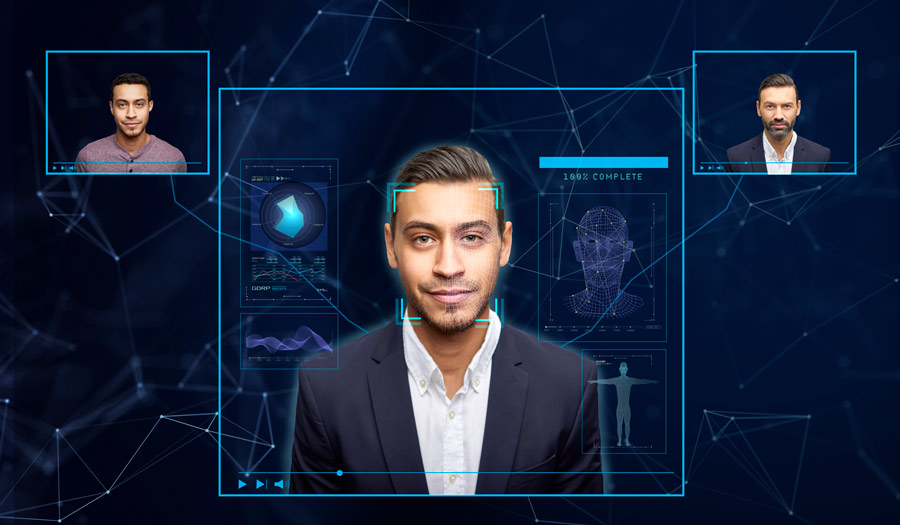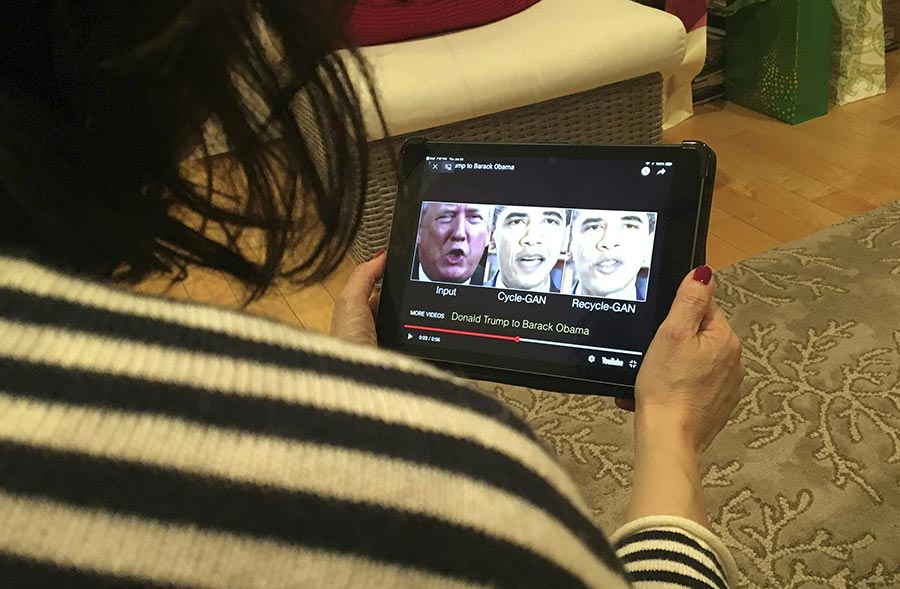 The Real Truth
The Real Truth
Article
Manipulated videos spreading across the internet are forcing people to distrust what they see and hear.
Learn the why behind the headlines.
Subscribe to the Real Truth for FREE news and analysis.
Subscribe NowNoelle Martine, an Australian Indian-Catholic woman, discovered at age 18 that her face had been photoshopped onto pornographic images.
Shocked, she went to the police for help. But in 2012 Australia had no laws specifically targeting fake pornographic images. She went to various government officials and even tried to hire a private investigator to find the source of the photographs. Each time, she was told that nothing could be done without specific laws regarding image abuse.
Miss Martin spent years contacting the sites hosting the images of her as well as the people who posted the images online. Those responsible would tell her she should be flattered or even blamed her for putting photos of herself on Facebook and other social media that they could use.
Her efforts contributed to Australia’s development of an agency dedicated to removing images of victims. But with the internet as widespread and uncontrollable as it is, it is nearly impossible to ever stop all attacks.
Even though Miss Martin was instrumental in getting the necessary laws passed to protect women from this abuse, it only broadened the attacks on her. The internet trolls came out in force and blamed her for the images that others had created of her. Pictures of her accepting awards for her activism were used to create even more pornographic images. Then advances in technology allowed for the creation of fake video and audio—which has come to be known as deepfakes—and Miss Martin began to see the emergence of convincing pornographic videos of her across the internet.
Miss Martin’s life is forever altered for the worse: “I think back to the time when I first discovered all the deepfake videos and recall the sensation of numbness. I had been targeted for so many years; it was a decade long campaign. I had spent my entire adult life watching helplessly as my image was used against me by men that I had never given permission to of any kind. And I was in so much pain. I don’t know how many videos of me now exist. These days, I try not to check.”
Hers is far from the only story.
“There are at least 14,678 deepfake videos—and counting—on the internet, according to a recent tally by a startup that builds technology to spot this kind of AI-manipulated content,” CNN reported in October 2019. “And nearly all of them are porn.” Deeptrace Labs reported in September that 96 percent of deepfake videos are pornography where likenesses of women were used without their consent.
But the potential for damaging lives goes beyond just women. In 2018, a simple application was made that allows non-tech-savvy users to create their own deepfake videos, further complicating the ability to control fake content online. This could be weaponized to change public opinion, including the capability of influencing political decisions.
“Deeptrace CEO and chief scientist Giorgio Patrini told CNN Business that the growth the company charted over just seven months shows the potential for false content to be created and quickly circulated. Even if one of these deepfake videos isn’t very realistic looking—at this point, plenty of them aren’t—it could still be good enough to influence many people’s opinions.”
“That is a fairly worrying threat for social media,” Mr. Patrini said to the news organization.
An example shows the extent of the threat is not limited to video. Some software can fake a voice after processing five seconds of audio. Police believe cybercriminals used such software in March 2019 to convince the CEO of a British energy company that he was speaking to his boss from a German parent company. These criminals had the CEO transfer $243,000 to a bank in Hungary.
As the technology improves, the deception will only get worse. “In the short term, detection will be reasonably effective,” Subbarao Kambhampati, a professor of computer science at Arizona State University, said to the think tank Brookings Institution. “In the longer run, I think it will be impossible to distinguish between the real pictures and the fake pictures.”
What does this mean for society? “Some people already question the facts around events that unquestionably happened, like the Holocaust, the moon landing and 9/11, despite video proof. If deepfakes make people believe they can’t trust video, the problems of misinformation and conspiracy theories could get worse. While experts told CNN that deepfake technology is not yet sophisticated enough to fake large-scale historical events or conflicts, they worry that the doubt sown by a single convincing deepfake could alter our trust in audio and video for good,” CNN Business reported.
Tech Behind the Fake
 Rob Lever/AFP via Getty Images
Rob Lever/AFP via Getty Images“Deepfake” is the alias of a Reddit user who combined “deep learning” and “fake” to describe the kind of videos he produced. Today, anyone with a computer and internet access can create them.
In simple terms, deepfake software uses an algorithm called an autoencoder that maps a person’s face and places it onto another by aligning key features such as eyes, nose, lips, pupils and even wrinkles.
More sophisticated systems use generative adversarial networks (GANs). These have two components: a generator that creates fake images and a discriminator that looks for flaws.
If the discriminator finds flaws in the forged image, it informs the generator how to improve and to try again. The process of detection and improvement continues until the entire video is completed.
This technology was used to insert actor Peter Cushing into Rogue One: A Star Wars Story, which began filming 21 years after his death. It has also been used to make soccer star Brian Beckham appear to speak nine languages.
GAN could improve to the point it creates synthetic humans who look, act and respond like real people. It could provide grieving people the opportunity to say goodbye to a deceased relative or meet a parent or grandparent who died before a child was born. Alzheimer’s patients could have conversations with a younger version of their loved ones that they can still remember.
This sounds like pure science fiction, until you realize it is already here. The Dali Museum in Florida processed old interviews of artist Salvador Dali into 45 minutes of deepfake clips. The videos are played interactively with the museum’s visitors, who can take selfies with the deceased artist!
Nothing New
“There is no new thing under the sun,” stated ancient King Solomon (Ecc. 1:9). “The thing that has been, it is that which shall be; and that which is done is that which shall be done.”
Though Solomon never saw a video in his time, deepfake videos are just the latest iteration of a long history of people creating deceptive images.
The world’s first photograph was taken in 1826. Only 20 years later, a person in a photo negative was painted over and subsequently blocked from the printed image. Throughout the rest of the 19th century, wealthy clients and magazine editors retouched images with increasing sophistication.
Not all image editing was for malicious or political purposes. “Most of the earliest manipulated photographs were attempts to compensate for the new medium’s technical limitations—specifically, its inability to depict the world as it appears to the naked eye,” Mia Fineman, an assistant curator of photography at the Met, said in an interview with PBS.
In most cases, manipulation was used to make the image “look the way it felt” rather than to deceive.
A famous example is a cut-out of Abraham Lincoln’s face from an 1860 photograph of him pasted onto the body of Vice President John Calhoun in an 1852 engraving. The composite image, which portrayed the 16th president wearing a robe in a near-Napoleonic pose, circulated during a wave of heroic-style pictures of the president after he was assassinated. For a century, no one noticed the image was fake.
Photoshop computer software debuted in 1987 and ushered in a new era of deceptive image manipulation. With a computer and the right software, anyone could change images. Advertisers, publishers and propaganda machines churned out so many digitally altered images that the term “photoshop” can now refer to any photo manipulation.
Enter deepfakes, which are becoming more difficult to decipher. “Presently, there are slight visual aspects that are off if you look closer, anything from the ears or eyes not matching to fuzzy borders of the face or too smooth skin to lighting and shadows,” Peter Singer, cybersecurity and defense strategist at the New America think tank, stated to CNBC.
But the “tells” are becoming harder to find as the technology increases, Mr. Singer said.
Detection methods “often lag behind the most advanced creation methods,” warned John Villasenor, a senior fellow in Governance Studies and the Center for Technology Innovation at Brookings Institution. This could leave them with a dilemma: “Will people be more likely to believe a deepfake or a detection algorithm that flags the video as fabricated?”
Hidden Danger
Every tool that mankind has developed can be used for good or evil. The internet has allowed for instant communication, online schooling and access to a plethora of “do-it-yourself,” or DIY, videos. Yet it also allows for the intentional spread of misinformation, the hacking and stealing of personal information, and for pushing extremist ideals abroad.
Similarly, deepfake videos are generally harmless. But, more often than not, they are used as “a perfect weapon for purveyors of fake news who want to influence everything from stock prices to elections,” an MIT technology report stated.
Independent research from Gallup, Pew Research, and Hill-HarrisX came to the same conclusions. Less than half of Americans believe the news stories they hear, and over half believe the media ignores important stories in favor of pushing their own agenda using “fake news.”
With the 2020 presidential elections approaching, experts believe it is just a matter of time before deepfakes promoting or denigrating candidates will proliferate.
And the problem is most people lack the mistrust needed to see through the deception. Even when viewers know that the videos are altered, the deception still works. People are simply inclined to believe what they want to believe.
The research organization RAND Corporation reported: “‘Deepfakes play to our weaknesses,’ explains Jennifer Kavanagh, a political scientist at the RAND Corporation and coauthor of ‘Truth Decay,’ a 2018 RAND report about the diminishing role of facts and data in public discourse. When we see a doctored video that looks utterly real, she says, ‘it’s really hard for our brains to disentangle whether that’s true or false.’ And the internet being what it is, there are any number of online scammers, partisan zealots, state-sponsored hackers and other bad actors eager to take advantage of that fact.”
People who cannot trust what they see are faced with three options: accept the deception, try to ignore it, or spend time getting news from multiple sources to discern the truth. Daunted by the effort required to find truth, many give in to deception.
Thousands of years before the discovery from these polls, a seldom-quoted passage in the Bible was written about this human tendency: “The heart is deceitful above all things, and desperately wicked: who can know it?” (Jer. 17:9).
Lies and deception are tools that have been used for millennia as a way for people to get what they want, whether individually or on a national, corporate or political scale. But with the advent of sophisticated deepfake technology in a world where deceit is already so rampant, a time is approaching where facts can be completely distorted and “truth is fallen in the street, and equity [meaning straightforwardness, integrity, truth, or right] cannot enter. Yes, truth fails” (Isa. 59:14-15).
How many times have you found yourself at a loss to locate any source of truth? Looking at the media landscape, it becomes easy to say: “Truth fails.”
But there is a place you can turn to find truth. God’s Word—the Bible—states that it is truth (John 17:17 and II Tim. 2:15). God says that He cannot lie (Titus 1:2) and that His words will not pass away (Matt. 24:35). In a turbulent time when you are not sure who to believe, God’s Word provides comfort and stability on which you can rely.
Yet you do not have to remain unsure whether to take Scripture at face value—you can actually prove it. The booklet Bible Authority...Can It Be Proven? shows that you can determine, beyond all doubt, that the Bible is truth.
This magazine uses God’s Word as the bedrock foundation from which to view and understand world events, bringing you the truth hidden beneath the lies.
For more on the faltering trust in news media, read The Real Truth article ‘What Is Truth?’ – Finding Facts amid Fiction.



